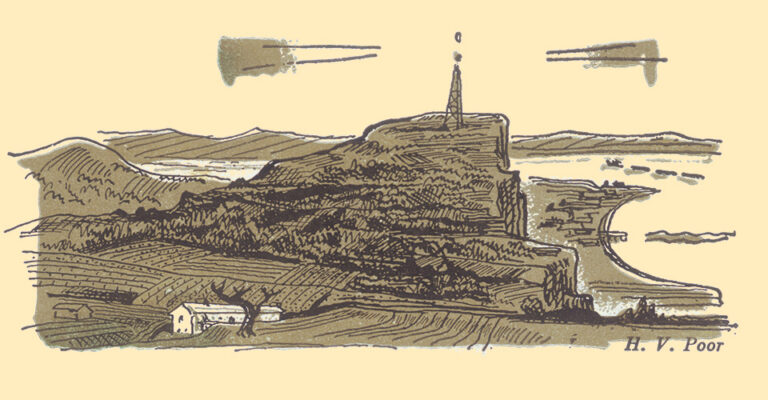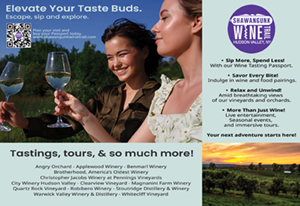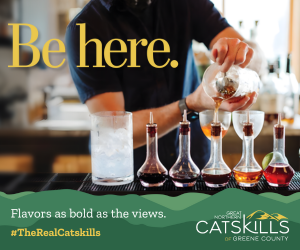Everett S. Crosby (1911-1994) and his wife Alma, founded and operated the historic High Tor Vineyards located on the south side of High Tor Mountain in Rockland County from 1950 to 1971. The winery remained in operation until 1989. Everett grew up in Alameda, California, where even as a teenager, he was drawn to growing grapes, and making and enjoying wine.
In 1941, after graduating from the University of Southern California, he and his wife Alma moved to a penthouse apartment on East 73rd Street in Manhattan. The Crosbys moved to this apartment with an eye towards having a garden and to grow a few Concord vines in butter tubs. Initially, they were both drawn to New York City’s employment opportunities in the music and arts community.
In the summer of 1942, as his Concord vines flowered and set out two grape clusters, he went to work for the Office of War Information, which would soon become the Voice of America. It was a demanding six day a week job due to America’s recent entry into WWII. In 1949, Everett started looking for land to grow more grapes and was made aware of the High Tor Mountain area in the Palisades, high above Haverstraw in Rockland County, New York. A Broadway play written by Maxwell Anderson had the same name.
At the age of 38, while looking for five acres of farmland, he found the 78-acre Van Orden Farm in New City, New York, that he ultimately purchased in January 1950. The deed to this farm dated back to King George III, and had a small farmhouse that was built in 1790, a bungalow with a leaky roof, and a dilapidated barn. The rafters of the small farmhouse had hand-hewn cedar beams joined together with wooden pegs. The house was lengthened in 1890 with a new wing. Most of the land was rolling with a boulder-strewn precipice that rose to the summit of High Tor Mountain. Initially, much of this land was farmed by Elmer Van Orden, a bachelor, who was the last of that Van Orden line. At Elmer’s death in 1942, only about fifteen acres immediately surrounding the house showed any trace of having been cleared.
The Dutch influence in this part of Rockland County is heavy. Some maintain that the name Van Orden is a corruption of the Dutch words van norden, meaning “from the north.” This farm had apparently been acquired by the Van Ordens by marriage in the middle of the 19th century, when Charity Youmans, from a local family that had extensive land holdings dating back to Dutch colonial days, married the man who became Elmer Van Orden’s father. Elmer never married, but several women lived with him over the course of his life. When his father died, he befriended August Weltie, an orphan from Germany, who was apprenticed to a Haverstraw brickyard. In 1892, August “Gus” Weltie, applied for a “temporary” position at the farm and stayed for almost sixty years. He worked for bed and board alone. When Elmer died, Gus received one-half of the farm with the right to live in the house. Gus was politically active in Democratic town politics. When he died at the age of 89, many prominent people attended his funeral.
The farmhouse had no electricity or running water when the Crosby’s purchased the 78-acre farm in 1950. For water, they utilized a nearby running spring. This historic farm would eventually become High Tor Vineyards, which was covered in the media by Craig Claiborne of The New York Times, the New York Herald Tribune, Robert Dana of the New York World-Telegram, and wine writers Frank Schoonmaker, Alexis Lichine, Leon Adams, and James Beard. High Tor wines were hailed by luminaries such as actor Burgess Meredith, band leaders Mitch Miller and Turk Murphy, and writers/cartoonists John Masters, Milton Caniff, Bill Mauldin, and Dave Breger. They were praised by connoisseurs and featured on the wine lists of many prestigious New York restaurants and clubs.
Setting up the Vineyard
After purchasing the Van Orden farm, the Crosbys needed to acquire knowledge to select the right grape varieties for their new farm in this new wine growing region, and to set out a new vineyard, construct a winery building, produce quality wine, and sell it. The Crosbys, with help from their friends and neighbors, did all of this in Rockland County.
To select the right grape varieties, they relied on the advice of Philip Wagner and his wife Jocelyn, who in 1945, had just established Boordy Vineyards & Nursery in Riderwood, Maryland. Philip Wagner, who had replaced the famous newspaperman H. L. Mencken, was the editor of the editorial page of the Baltimore Sun from1938 until his retirement in 1964. Around WWII, Wagner was responsible for bringing scores of French-American hybrid grape varieties from France via Canada to the United States. These grape varieties were hybrid-crosses of quality French vinifera grape varieties with hardy North American species that were fungus disease resistant, cold hardy, and productive. They also made quality wine.
The Crosbys purchased 3,500 vines that year. For the white varieties they planted Aurora, Seyval Blanc, Rayon d’Or, and Seibel 13.047, and the red varieties Baco Noir, Chelois, Chancellor, and Cascade. In later years, the red varieties Colobel, Maréchal Foch, Ravat 244 (probably Landot 244, Landal), and Landot 262 (probably Ravat 262) were planted, with much success. High Tor Vineyards was the first commercial winery in New York State and probably the East Coast to produce its wine entirely from French-American hybrids. The varieties first selected by the Crosbys in the early 1950s became some of the mainstay hybrids that were later planted in the ’60s and ’70s by wineries throughout the Hudson Valley, including Benmarl Vineyards, Brotherhood Winery, Cascade Mountain Winery, Clinton Vineyards, and Hudson Valley Wine Company, as well as many wineries across the Finger Lakes and newly established wineries on the East Coast. (For more on this aspect of Crosby’s work, see the author’s book Grapes of the Hudson Valley and Other Cool Climate Regions of the U.S. and Canada, 2nd Edition [2023, Flint Mine Press]).

The vineyard was set out with nine feet between each row with six-foot spacing between vines. The pruning system was very French with one cane of ten buds being left on each side of the head of each vine. The vines were placed on a French trellis system with low supporting wires of three to three and one half feet high. The vineyard was sprayed six to eight times each summer. The vineyard, as was the common practice then, was routinely cultivated to keep down weeds, with winter rye being planted in the fall as a cover crop to retain top soil and to build-up soil fertility during the winter months.
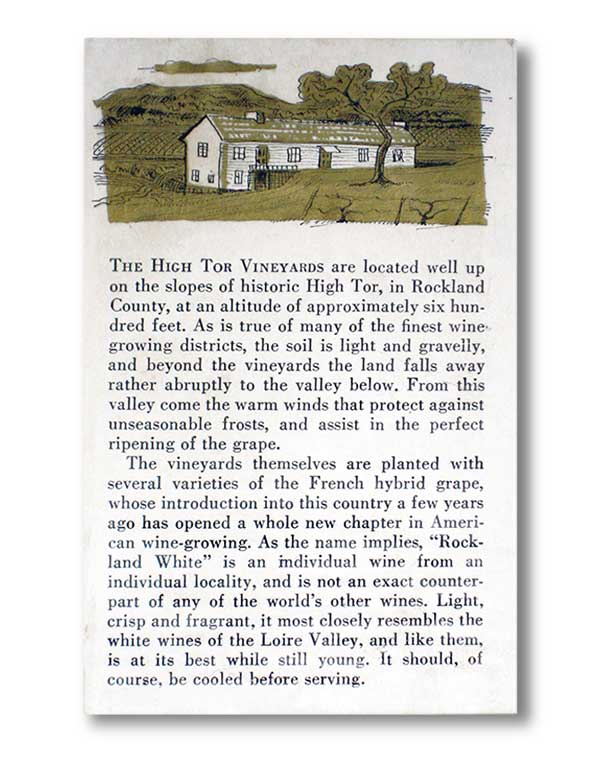
With the advice of Philip Wagner, the winery was constructed as a single-story concrete block building that was eighty feet long by forty feet wide with a poured concrete floor and nine-foot ceilings. The back room was placed eight and one half to nine feet deep underground where the barrel room and bottling took place. The winery was outfitted with running water, bottled gas for heating, a grape crusher, electric press, wine tanks, bottler, and label machine. It had four wooden tanks that held about 692 gallons of wine each. In France, wines are named and designated based on the region where the grapes are grown and the wine made. Hence, a Chablis or Champagne comes from those regions of France. At High Tor, they followed the same practice, and named most of their wines as Rockland White, Rockland Rosé, and Rockland Red, in addition to varietal wines made with Baco Noir, Chancellor, and Aurora.
In the early 1950s, there were few books on how to make wine in the eastern United States, so to learn more about winemaking, the Crosbys relied on the oral advice and books written by Philip Wagner, such as American Wines and How to Make Them (1936). In addition, Crosby relied on the advice of wine writer Frank Schoonmaker who suggested that the Crosbys tour the wine regions of Europe to learn how to make wines on the small scale that they were contemplating. The Crosbys happily took Schoonmaker’s advice and sailed for Southhampton on the H.M.S. Queen Elizabeth and then back to New York from Cherbourg on H.M.S. Queen Mary. Schoonmaker gave the Crosbys letters of introduction to wine producers in Vouvray, Burgundy, the Rhone, Bordeaux, and Alsace France; Rioja, Spain; Switzerland and Germany.
By 1956, with his vineyard in full production, Everett needed to quit his “day job,” which was at both the Voice of America, and later on as one of the so-called “Mad Men” who wrote advertising and scripts for radio and television programs. He gave up concert singing, radio acting, composing music, and photography because he “didn’t make a huge success of it.” Alma kept her part-time photography business. To save money, they sold their Victorian home that was on a mill pond in West Nyack and moved into the Van Orden farmhouse on a year-round basis.
To move into the farmhouse full time, the house needed to be updated to have reliable electricity, heating, plumbing, more living space, a bathroom, and a laundry room. As Crosby recalled, “A new room was added, doubling the size of the living room, which now being three steps higher than the addition, became the dining room. The ladder was replaced by a set of stairs, steep to be sure…”. Bathrooms were added and “the whole thing was capped off with a large wooden deck on two sides of the new living room.”
Harvest Parties and Critical Acclaim
For help to pick High Tor’s grape crop, the Crosby’s hosted a harvest party each year. On or about Labor Day, the first day of picking grapes commenced. The early-ripening white variety Aurora was probably the first to be picked at these harvest parties. At the initial party, family friends and neighbors such as writer John Masters, actor Burgess Meredith, comic-strip artist Milton Caniff, cartoonist Bill Mauldin, and band leaders Mitch Miller and Turk Murphy lent a hand. All brought a covered dish and the Crosbys supplied the wine. The first harvest party in 1952 drew about thirty-five people, which grew to about 125 people by 1956. In 1956, because of the warm summer weather, the harvest party started a few days before Labor Day while some grape must was already happily bubbling away. While some of the grapes harvested that day were brought down to be processed, another 240 bushels of grapes, about six tons, had to be brought down and processed the next day, when most of the guests had already gone.
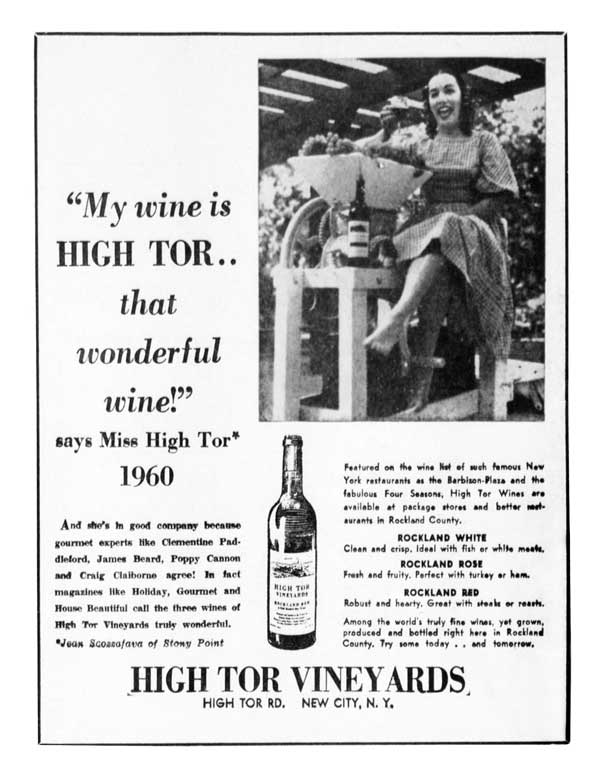
The Miller Family, owners of Benmarl Vineyards in Marlboro, New York, probably attended a few of these harvest parties. When the Millers’ Société des Vignerons was established at Benmarl in 1972, this same concept of having a harvest party or parties to help pick the grapes was instituted, as well. After the picking was over, a covered dish supper was had by all. As a teenage winery worker, I helped out at these parties. In fact, writer Frank Prial of The New York Times covered one of these parties in the fall of 1977, and a photo of me helping to harvest and bring the crop to the winery was included in the article.
Everett and Alma Crosby, their lifestyle and work at High Tor Vineyards was an inspiration to many new and budding vintners and aspiring winery owners in the Hudson Valley and across the East Coast. These individuals and wineries followed the Crosby’s lead at High Tor Vineyards in regard to the kinds of French-American hybrid grapes to grow, wines to be made, and how to sell their wines. Many of the grape varieties first selected by Wagner and Crosby continue to be grown in the Hudson Valley and the Northeast, including white varieties such as Seyval Blanc and red varieties Baco Noir, Chelois, and Marechal Foch. With our changing climate, these grape varieties are making a comeback because they are fungus disease resistant, cold hardy, survive late spring frosts, are productive, and drought and flood-resistant. All can be grown sustainably and make wonderfully flavorful wines and co-fermented beers and ciders.
By 1964 with the marriage of their daughter Averil and the desire to spend more time at their place on the island of Jamaica, the Crosbys started to slow down and began to start to phase out of the wine business by 1969. However, in 1971, Everett was contacted by Harper & Row, publishers in New York, to write their story. The book came out in 1973, The Vintage Years: The Story of High Tor Vineyards. The book, a critical success, lays out the story of how some of the first farm wineries on the East Coast started to shift from making wines with Native-American labrusca grape varieties to more sophisticated European vinifera-based French-American hybrid varieties.
Around 1970, James Cannon, then an advisor to Governor Nelson Rockefeller, and subsequently, the Domestic Policy Advisor to President Jerry Ford and U. S. Senate Majority Leader Howard Baker, had an interest in purchasing High Tor Vineyards. In 1971, the Vineyard was ultimately sold to Richard E. Voight, a Connecticut restaurateur, who employed the Episcopal Reverend Thomas L. Hayes as the winemaker. The winery was sold again in 1981 to New York economist Christopher Wells who did his best to revive High Tor. The winery closed permanently in 1989.
The property was purchased by the Palisades Interstate Park Commission and is now dedicated parkland. Sadly, during the tumultuous transfer of the property from Wells to a private housing developer before it was purchased by the Palisades Inter-state Park Commission, the 1790 farm house burned to the ground. The foundation of the farmhouse still exists with the chimney still standing that has ornamental deft Dutch tiles, as was the tradition for many Hudson Valley Dutch homes. The old Van Orden farm is now part of the Park Commission’s parklands and a marker indicates to trail hikers where the winery foundation is located.
A New Beginning for High Tor
Since 2005, history buff Marvin Baum of New City, New York, had been interested in starting a winery and reviving the local High Tor Vineyards name, however with the acquisition of the original High Tor Vineyards property by the Palisades Interstate Park Commission, the prospect of finding adequate land to start a vineyard in New City was extremely unlikely.
However, in 2022, a hidden three-acre former farm on North Little Tor Road became available, not far from the original High Tor Vineyards that had been on High Tor Road. In addition, Baum learned that this former farm had been a private vineyard and winery between 1960 and 1990, so this location seemed destined to be the perfect location for a new vineyard and winery. After acquiring the initial three acres, Baum then acquired an adjoining acre property in 2024 that included a building well-suited for wine making, and additional land for an expanded new vineyard nursery (planted in the spring of 2025) and for a future additional vineyard.
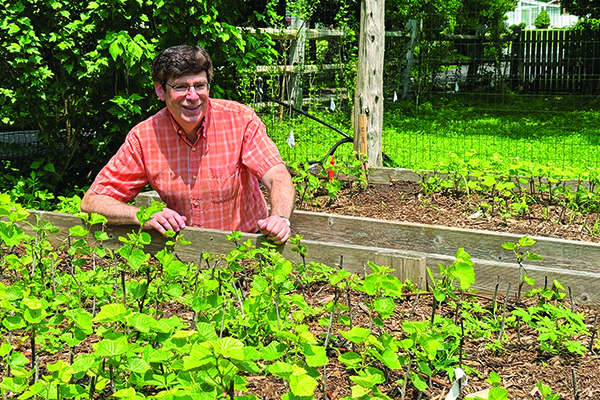
As of 2025, work continues at the new High Tor with building renovations underway for a tasting room and event space, with plans to open the winery to the public sometime in 2026.
Demonstrating that the pioneering work of the Crosbys continues to this day, Baum has chosen to grow Heritage grapes in Rockland County to make quality wines using organic management techniques. The new High Tor Vineyards plans to produce kosher-certified wines, host small private events, and concentrate on growing Hudson Valley Heritage grape varieties including Bacchus, Campbell Early, Croton, Empire State, Iona, and Jefferson, as well as Agwam, Burdin 6055, Cayuga White (a “grandchild” of Iona developed by Cornell in the 1940s), Chambourcin, and Vidal varieties.
High Tor Vineyards played an important and innovative role in East Coast winemaking with its early pioneering work on French hybrids. That pioneering spirit continues today new wineries promoting Heritage grapes like the new High Tor Vineyards.
Header: Closeup of artwork from an original High Tor wine label, illustrated by famed local artist Henry Varnum Poor.

